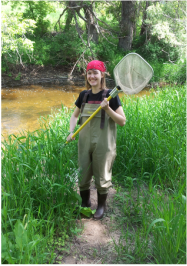Research in the Vander Zanden Lab

The Vander Zanden Lab is broadly interested in the ecology, threats, and management of freshwater ecosystems. We employ a wide range of approaches to address these questions, including long-term studies, whole-lake experiments, empirical observations, stable isotope analysis, and statistical and simulation modeling. Current Vander Zanden Lab projects include: declines in inland walleye fisheries in the Great Lakes region, the ecology of deepwater coregonine fishes in the Great Lakes, reintroduction of native coldwater fishes in northern Wisconsin, impacts of lakeshore development, impacts of invasive species on water quality in the Madison lakes, and long-term changes using paleolimnological approaches. Below are several broad research themes in the Vander Zanden Lab:
Aquatic invasive species
Work in the Vander Zanden Lab examines the spread, abundance, and impacts of invasive species in lakes and streams. For more information, see our aquatic invasive species page. Invasive species are recognized as a threat to aquatic ecosystems, and are among the most irreversible of human impacts. With so many lakes and streams, how can managers focus efforts so as to be maximally effective? We have recently developed a ‘smart prevention’ framework which forecasts invasive species spread and identifies systems that are most vulnerable. We also study the abundance and impacts of invasive species. Invasive species abundance varies widely from place to place, which translates to spatially variable ecological and economic impacts. Recent whole-lake experiments in Sparkling and Crystal Lakes have provided unique insights into the role of aquatic invasive species in lake food webs. This work is carried out in conjunction with NTL-LTER.
Benthic processes in lakes
We work on nearshore habitats and benthic processes in lakes. Work in collaboration with Yvonne Vadeboncoeur (Wright State University) and Sudeep Chandra (University of Nevada - Reno) examines the role of benthic primary production in lakes, links to higher trophic levels, and the implications of benthic energy flow for lake food webs. We also work on the role of benthic production in linking aquatic and terrestrial food webs - much of this work has been conducted at Lake Myvatn, Iceland.
Food webs, fisheries, and restoration
A common theme has been to bring a food web approach to the restoration of lakes. One ongoing project examining declines in walleye populations in Wisconsin. We are examining several hypotheses regarding the drivers - harvest, climate change, species interactions, or some combination of these factors. Much of this work involves examining food web interactions, as food web changes can become barriers to fisheries recovery. Related projects involve conducting stable isotope analysis on museum specimens to reconstruct long-term food web change, and assess how this might inform restoration of lake ecosystems.
Aquatic invasive species
Work in the Vander Zanden Lab examines the spread, abundance, and impacts of invasive species in lakes and streams. For more information, see our aquatic invasive species page. Invasive species are recognized as a threat to aquatic ecosystems, and are among the most irreversible of human impacts. With so many lakes and streams, how can managers focus efforts so as to be maximally effective? We have recently developed a ‘smart prevention’ framework which forecasts invasive species spread and identifies systems that are most vulnerable. We also study the abundance and impacts of invasive species. Invasive species abundance varies widely from place to place, which translates to spatially variable ecological and economic impacts. Recent whole-lake experiments in Sparkling and Crystal Lakes have provided unique insights into the role of aquatic invasive species in lake food webs. This work is carried out in conjunction with NTL-LTER.
Benthic processes in lakes
We work on nearshore habitats and benthic processes in lakes. Work in collaboration with Yvonne Vadeboncoeur (Wright State University) and Sudeep Chandra (University of Nevada - Reno) examines the role of benthic primary production in lakes, links to higher trophic levels, and the implications of benthic energy flow for lake food webs. We also work on the role of benthic production in linking aquatic and terrestrial food webs - much of this work has been conducted at Lake Myvatn, Iceland.
Food webs, fisheries, and restoration
A common theme has been to bring a food web approach to the restoration of lakes. One ongoing project examining declines in walleye populations in Wisconsin. We are examining several hypotheses regarding the drivers - harvest, climate change, species interactions, or some combination of these factors. Much of this work involves examining food web interactions, as food web changes can become barriers to fisheries recovery. Related projects involve conducting stable isotope analysis on museum specimens to reconstruct long-term food web change, and assess how this might inform restoration of lake ecosystems.
